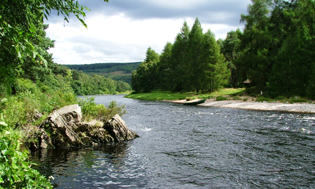 The Scottish Environment Protection Agency (SEPA) has recently confirmed that Scottish & Southern Energy (SSE) has withdrawn an application to take yet more water from the Spey Catchment as part of their proposals to re-water the River Garry in the Tay Catchment.
The Scottish Environment Protection Agency (SEPA) has recently confirmed that Scottish & Southern Energy (SSE) has withdrawn an application to take yet more water from the Spey Catchment as part of their proposals to re-water the River Garry in the Tay Catchment.
SSE originally put forward proposals aimed at implementing the European Commission-inspired Water Framework Directive. This requires the majority of Europe’s rivers and burns to achieve “Good Ecological Status” by 2027.
To comply with the provisions of this legislation, SSE had proposed re-watering the River Garry in the Tay Catchment, which runs alongside the A9 in the Drumochter Pass in Perthshire, the flow from which is currently almost completely diverted to produce hydro-electricity. This would have resulted in a small loss of power-generating water. To compensate for this, SSE wanted to take yet more water from the Spey Catchment, via the Rivers Tromie and Truim, which are tributaries of the iconic River Spey – itself designated as a Special Area of Conservation under European legislation – and from which SSE already divert significant volumes of water into the Tay Catchment.
The Spey Fishery Board opposed these proposals when they were first put forward and has worked hard since then to oppose any measures which would have led to a further reduction in water flows in the Spey catchment. The Board has worked tirelessly, together with SEPA, SNH, the CNPA and SSE, to evaluate the impacts these proposals were likely to have – not just on the Rivers Tromie and Truim, but also on the wider Spey catchment – and our knowledge and understanding of the ecology and river flows has increased considerably as a result. Despite the withdrawal of SSE’s application, the Board recognises that the Water Framework Directive still needs to be implemented.
Spey Fishery Board Director, Roger Knight said, “The upper Spey catchment is already substantially impacted by water diversion schemes. Besides the SSE schemes on the Truim and the Tromie, significant volumes of water are diverted to Fort William by Rio Tinto Alcan at Spey Dam, above Kingussie and near Laggan. It has always been the Spey Board’s position that the use of water in the upper Spey should be viewed holistically, rather than on a project- or case-by-case basis. The River Spey is a jewel amongst Scotland’s salmon fishing rivers. Angling on the Spey generates over £ 15 million each year for the local economy and supports over 360 full-time-equivalent jobs. The preservation of the River’s habitat is vital if the rural economy it supports is not to be jeopardised.” He added, “The Board hopes and believes that the opportunity afforded by the withdrawal of SSE’s application will give SEPA the chance to review the whole scenario surrounding the use of water as a resource in the upper Spey and to apply the technology and knowledge which we now possess to this important issue. The Board looks forward to working with SEPA to achieve this aim.”
